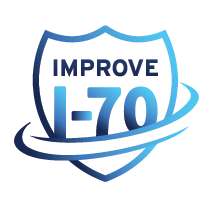Environmental Studies
Environmental studies, as required by the National Environmental Policy Act (NEPA), have occurred for this corridor, beginning in 2000. An Environmental Impact Statement (EIS) was performed and completed for the project corridor in 2011. Subsequent re-evaluations of the EIS document were performed in 2017 and in 2023 respectively because over five years had passed since the previous study was completed. Each re-evaluation included:
- Re-evaluation of the potential impacts of the previously determined preferred alternative
- Current conditions and related mitigation measures that may have changed
- Engagement with stakeholders to provide a project status and update previous feedback
- Preparation of the project to move forward into design.
Environmental Study, Public Information Timeline (2000-2023)
In August 2000, MoDOT, the Mid-America Regional Council, and the Kansas City Area Transportation Authority started a Major Investment Study (MIS) for the I-70 corridor in Jackson County.
The study area spanned approximately 28 miles from Kansas City Missouri’s Central Business District (CBD) Freeway Loop to the State Routes F/H interchange in Oak Grove, Missouri.
The objective of the I-70 MIS was to identify a multimodal investment strategy to address transportation needs in a manner consistent with regional policy goals. The I-70 MIS concluded in November 2004, and it identified a package of recommendations that included the reconstruction and widening of the existing I-70 facility.
In July 2008, MoDOT in partnership with the Federal Highway Administration initiated the I-70 First Tier Environmental Impact Statement (EIS) process for approximately 18 miles of I-70 corridor from the end of the last ramp termini east of the Missouri and Kansas state line to east of the I-470 interchange, including the entire Kansas City, Missouri’s Downtown Central Business District (CBD) Freeway Loop.
Its purpose was to determine an improvement strategy for the corridor to address the following needs - improve safety, reduce congestion, restore and maintain existing infrastructure, improve accessibility, and improve goods movement.
Various concepts were combined to develop 15 initial strategies that were screened down to four first tier strategies.
These four strategies included the No-Build Strategy, Improve Key Bottlenecks Strategy, Add General Lanes Strategy, and Transportation Improvement Corridor Strategy.
After analysis and public review, the First Tier EIS identified a Selected Strategy to improve the I-70 corridor.
The Selected Strategy is the Improve Key Bottlenecks Strategy from the downtown loop to east of I-435. From east of I-435 to I-470, the Selected Strategy is either the Improve Key Bottlenecks Strategy or the Add General Lanes Strategy. The I-70 First Tier EIS concluded with a Record of Decision in April 2011. The First Tier EIS recommended that for the second tier environmental studies, the 18-mile I-70 corridor be divided into five sections of independent utility (SIU).
The intent of the second-tier environmental studies is to build on and extend the work of the First Tier EIS for improving I-70 as part of the Mid-America Regional Council’s long-range transportation plan.
Each SIU will be evaluated to the appropriate level of detail (CE, EA, or EIS) within the National Environmental Policy Act process.
In August 2009, MoDOT in partnership with the Federal Highway Administration completed a Supplemental Environmental Impact Statement across the state incorporating truck-only lanes on I-70 between Kansas City and St. Louis. The study area included 9 miles of I-70 in Jackson County from east of the I-470 interchange to the State Routes F/H interchange in Oak Grove.
In December 2011, the Missouri Department of Transportation (MoDOT) and the Federal Highway Administration completed a Second Tier Environmental Impact Statement (EIS) for approximately 6.8 miles of I-70 from west of the Paseo Boulevard interchange to east of the Blue Ridge Cutoff interchange. This study encompassed two sections of independent utility (SIU) from the I-70 First Tier EIS, which are the Urban SIU (Paseo Boulevard to U.S. 40) and I-435 Interchange SIU (U.S. 40 to Blue Ridge Cutoff). The Second Tier EIS carried forward and refined the needs identified from the First Tier EIS and conduct an alternatives analysis based on the Improve Key Bottlenecks Strategy.
Through this study, more specific definitions of the improvements and their potential impacts were developed for consideration by the general public and the various environmental and community resource agencies. Examples of these improvements include modifying access, fixing existing pavement and bridges, improving interchange ramps, adding collector distributor roads, and providing for bus transit on shoulder. The Second Tier EIS also evaluated a no-build alternative and alternatives coordinated with ongoing regional transit studies.
This study concluded in spring 2017.
Design-Build Procurement Timeline (2023-2024)
The pre-qualified teams are as follows:
- Clarkson-Radmacher Joint Venture: Clarkson Construction Company and Radmacher Brothers Excavating Company with HNTB Corporation
- Lunda Team: Lunda Construction Company with Parsons
DBE partners were invited to an open house style meeting to learn more about the Improve I-70 Kansas City Design-Build Project from the two selected pre-qualified teams.
Clarkson-Radmacher Joint Venture selected for Improve I-70 KC Design-Build project.
View Press Release.
The project team holds public information meeting to share project updates and construction impacts.

